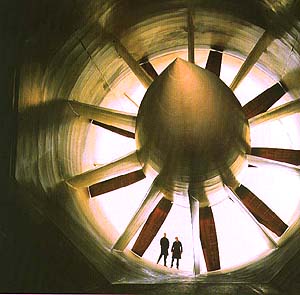 This equation has been so thoroughly accepted as correct that when data from wind tunnel experiments did not agree with the Law of the Wall's predictions, researchers sought ways to correct their experimental methods.
This equation has been so thoroughly accepted as correct that when data from wind tunnel experiments did not agree with the Law of the Wall's predictions, researchers sought ways to correct their experimental methods.
However, according to calculations by Berkeley Lab's Alexandre Chorin and Grigory Barenblatt, under the high-speed turbulent conditions that commonly occur in aerodynamics as well as many industrial situations, it is the Law of the Wall that breaks down. The forces exerted by turbulence can be very different from what the Law would predict. A more accurate model should lead to better, safer and more economical designs.
"The Law of the Wall was viewed as one of the few certainties in the difficult field of turbulence, and now it has been dethroned," Chorin said when this discovery was announced. "Generations of engineers who learned the law will have to abandon it. Many textbooks will have to be revised."

|
(Click on image to enlarge)
|
|
Turbulent forces increase drag, which is why aircraft wings are designed to minimize the turbulent flow of air around them.
|
Test results from the latest and most accurate wind tunnel experiments support the assertions of Chorin and Barenblatt. A key to their theoretical breakthrough was to ask the right question for experimental data to answer. This enabled them to finally check the accuracy of the Law of the Wall.
"For years, people have looked at turbulent flow without understanding what they saw," said Chorin. "The theory we developed led to predictions of a beautiful and complex structure in turbulence near walls that could be seen in the experimental data."
In mathematical terms, Chorin and Barenblatt showed that correct descriptions of the effects of turbulence on solid objects-referred to as "walls" in aerodynamic studies-require a family of "scaling laws" rather than a single "Law of the Wall."
| Lead scientist on this project
|
|
|
|
|
|
Mathematically, the solutions of the equations of motion in fluid mechanics are chaotic at high speeds, even the most minute perturbations change them. "Because of this," says Chorin, "what is of interest is not specific solutions, which we may never observe, but the ability to make statistical predictions based on collections of solutions. Such collections of solutions are amenable to rigorous analysis by statistical methods."
Chorin and Barenblatt have made progress in this rigorous analysis that has contributed to their debunking of the Law of the Wall. "What was a general mathematical theory has now been validated by the data in a specific problem," says Chorin. "This happy agreement of theory and experimental data constitutes a step toward a fundamental theory of turbulence."
- Lynn Yarris



 This equation has been so thoroughly accepted as correct that when data from wind tunnel experiments did not agree with the Law of the Wall's predictions, researchers sought ways to correct their experimental methods.
This equation has been so thoroughly accepted as correct that when data from wind tunnel experiments did not agree with the Law of the Wall's predictions, researchers sought ways to correct their experimental methods.

